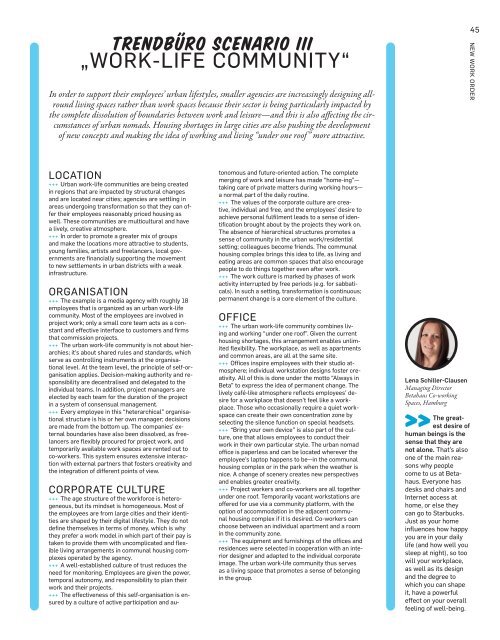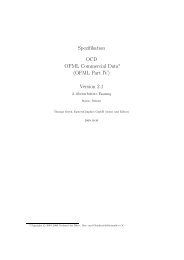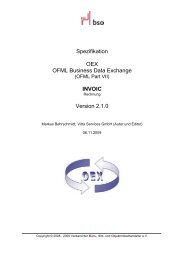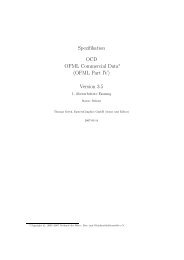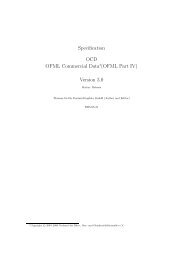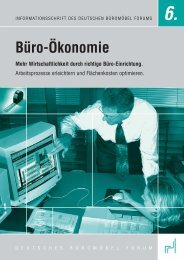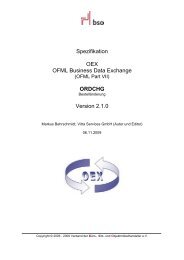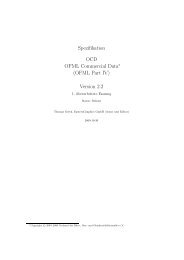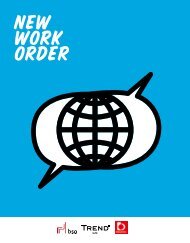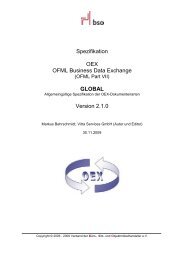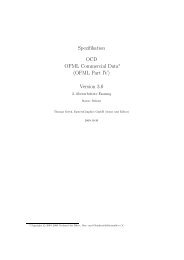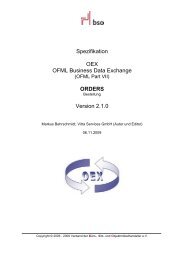New Work Order - Orgatec
New Work Order - Orgatec
New Work Order - Orgatec
- No tags were found...
You also want an ePaper? Increase the reach of your titles
YUMPU automatically turns print PDFs into web optimized ePapers that Google loves.
Trendburo ScENARIO III„<strong>Work</strong>-life community“In order to support their employees’ urban lifestyles, smaller agencies are increasingly designing allroundliving spaces rather than work spaces because their sector is being particularly impacted bythe complete dissolution of boundaries between work and leisure—and this is also affecting the circumstancesof urban nomads. Housing shortages in large cities are also pushing the developmentof new concepts and making the idea of working and living “under one roof ” more attractive.45<strong>New</strong> <strong>Work</strong> orderLocation+++ Urban work-life communities are being createdin regions that are impacted by structural changesand are located near cities; agencies are settling inareas undergoing transformation so that they can offertheir employees reasonably priced housing aswell. These communities are multicultural and havea lively, creative atmosphere.+++ In order to promote a greater mix of groupsand make the locations more attractive to students,young families, artists and freelancers, local governmentsare financially supporting the movementto new settlements in urban districts with a weakinfrastructure.Organisation+++ The example is a media agency with roughly 18employees that is organized as an urban work-lifecommunity. Most of the employees are involved inproject work; only a small core team acts as a constantand effective interface to customers and firmsthat commission projects.+++ The urban work-life community is not about hierarchies;it’s about shared rules and standards, whichserve as controlling instruments at the organisationallevel. At the team level, the principle of self-organisationapplies. Decision-making authority and responsibilityare decentralised and delegated to theindividual teams. In addition, project managers areelected by each team for the duration of the projectin a system of consensual management.+++ Every employee in this “heterarchical” organisationalstructure is his or her own manager; decisionsare made from the bottom up. The companies’ externalboundaries have also been dissolved, as freelancersare flexibly procured for project work, andtemporarily available work spaces are rented out toco-workers. This system ensures extensive interactionwith external partners that fosters creativity andthe integration of different points of view.Corporate culture+++ The age structure of the workforce is heterogeneous,but its mindset is homogeneous. Most ofthe employees are from large cities and their identitiesare shaped by their digital lifestyle. They do notdefine themselves in terms of money, which is whythey prefer a work model in which part of their pay istaken to provide them with uncomplicated and flexibleliving arrangements in communal housing complexesoperated by the agency.+++ A well-established culture of trust reduces theneed for monitoring. Employees are given the power,temporal autonomy, and responsibility to plan theirwork and their projects.+++ The effectiveness of this self-organisation is ensuredby a culture of active participation and autonomousand future-oriented action. The completemerging of work and leisure has made “home-ing”—taking care of private matters during working hours—a normal part of the daily routine.+++ The values of the corporate culture are creative,individual and free, and the employees' desire toachieve personal fulfilment leads to a sense of identificationbrought about by the projects they work on.The absence of hierarchical structures promotes asense of community in the urban work/residentialsetting; colleagues become friends. The communalhousing complex brings this idea to life, as living andeating areas are common spaces that also encouragepeople to do things together even after work.+++ The work culture is marked by phases of workactivity interrupted by free periods (e.g. for sabbaticals).In such a setting, transformation is continuous;permanent change is a core element of the culture.Office+++ The urban work-life community combines livingand working “under one roof”. Given the currenthousing shortages, this arrangement enables unlimitedflexibility. The workplace, as well as apartmentsand common areas, are all at the same site.+++ Offices inspire employees with their studio atmosphere;individual workstation designs foster creativity.All of this is done under the motto “Always inBeta” to express the idea of permanent change. Thelively café-like atmosphere reflects employees' desirefor a workplace that doesn’t feel like a workplace.Those who occasionally require a quiet workspacecan create their own concentration zone byselecting the silence function on special headsets.+++ “Bring your own device” is also part of the culture,one that allows employees to conduct theirwork in their own particular style. The urban nomadoffice is paperless and can be located wherever theemployee’s laptop happens to be—in the communalhousing complex or in the park when the weather isnice. A change of scenery creates new perspectivesand enables greater creativity.+++ Project workers and co-workers are all togetherunder one roof. Temporarily vacant workstations areoffered for use via a community platform, with theoption of accommodation in the adjacent communalhousing complex if it is desired. Co-workers canchoose between an individual apartment and a roomin the community zone.+++ The equipment and furnishings of the offices andresidences were selected in cooperation with an interiordesigner and adapted to the individual corporateimage. The urban work-life community thus servesas a living space that promotes a sense of belongingin the group.Lena Schiller-ClausenManaging DirectorBetahaus Co-workingSpaces, HamburgThe greatestdesire ofhuman beings is thesense that they arenot alone. That’s alsoone of the main reasonswhy peoplecome to us at Betahaus.Everyone hasdesks and chairs andInternet access athome, or else theycan go to Starbucks.Just as your homeinfluences how happyyou are in your dailylife (and how well yousleep at night), so toowill your workplace,as well as its designand the degree towhich you can shapeit, have a powerfuleffect on your overallfeeling of well-being.


